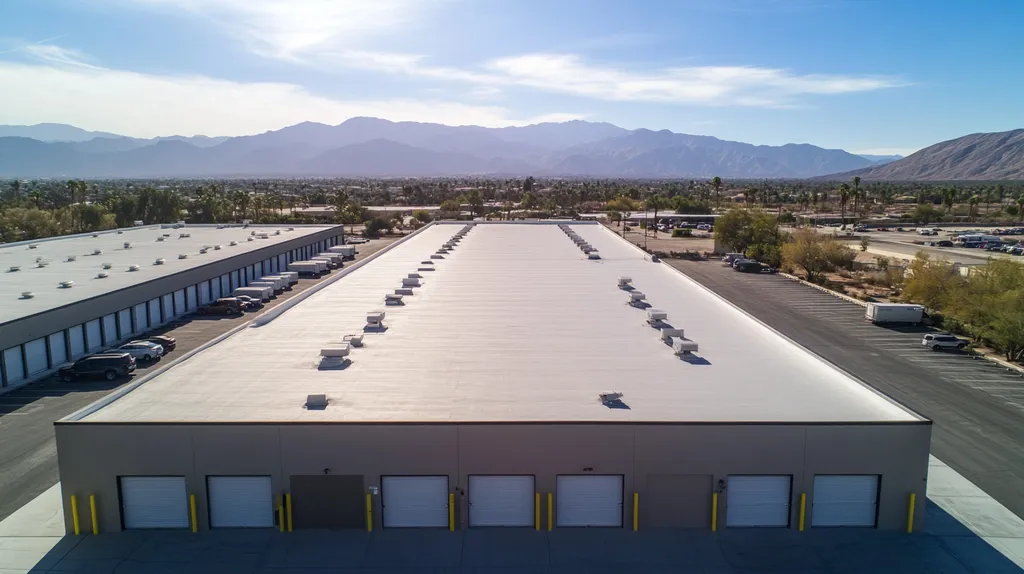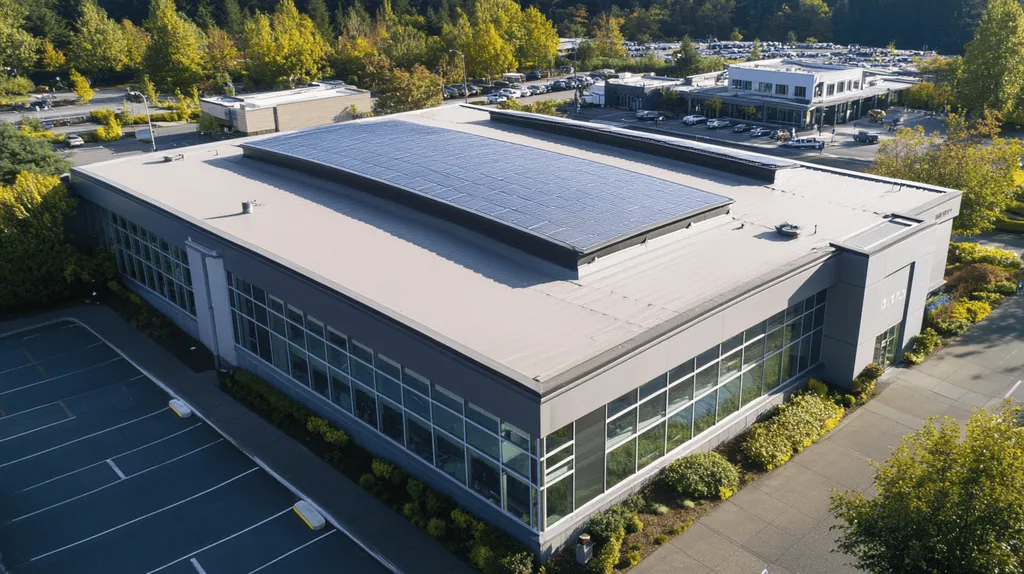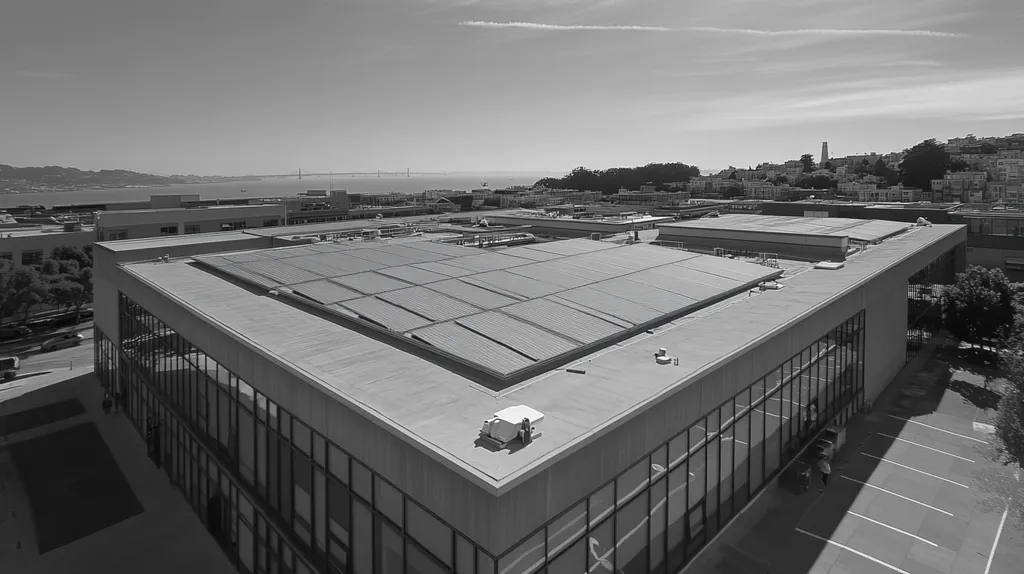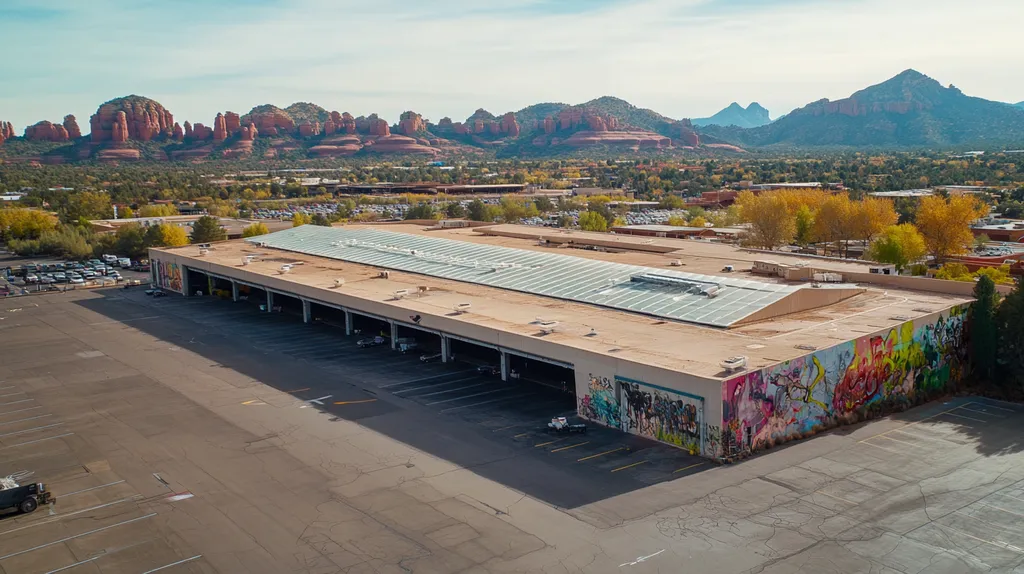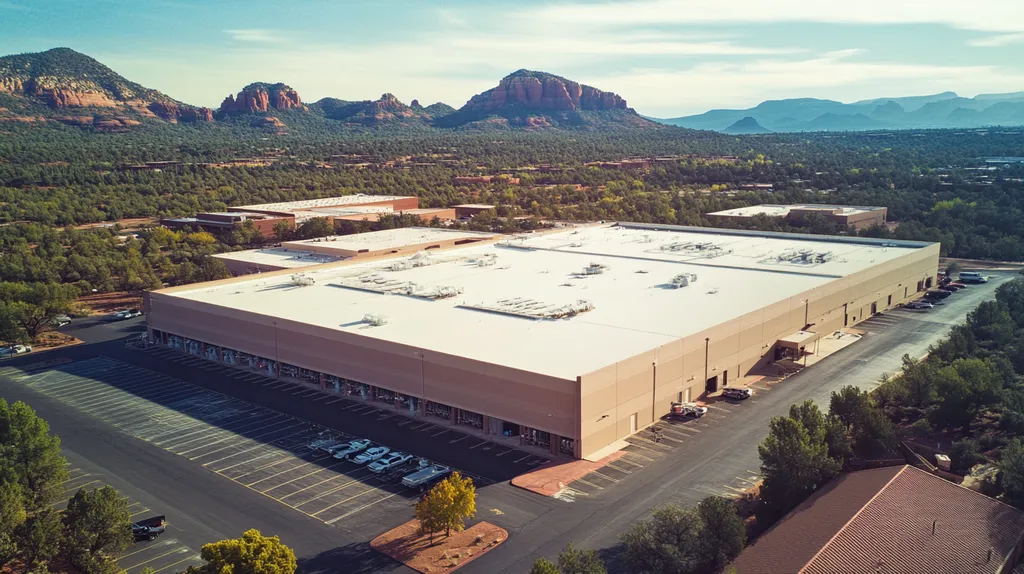Industrial roofing warranties represent a $2.4 billion segment of the commercial construction industry, yet research shows that 35% of warranty claims are denied due to systemic issues with current coverage options.
Property owners and facility managers face mounting challenges with traditional warranty structures that often provide inadequate protection against common roofing failures.
This analysis examines critical gaps in existing warranty frameworks, explores underlying causes of coverage limitations, and presents data-driven alternatives for more effective roof system protection.
SECTION 1: CURRENT PRACTICES
Selecting the right roofing warranty is critical for ensuring the long-term reliability and cost-effectiveness of industrial roofing systems. Statistics reveal that approximately 20% of commercial roofs develop leaks within the first few years of installation. This underscores the importance of understanding warranty options. Property owners and facility managers must become familiar with the various warranty types available, along with their specific benefits and drawbacks, to make informed and strategic decisions.
Types of Commercial Roof Warranties
Commercial roof warranties typically fall into two main categories: material warranties and workmanship warranties. Material warranties, issued by manufacturers, cover defects in roofing materials. These generally specify an operational period ranging from 10 to 30 years.
Workmanship warranties, on the other hand, are provided by contractors and ensure proper installation. Their durations can vary significantly, usually lasting between two to ten years. Understanding these differences is essential, as they directly influence long-term performance and related costs.
Some manufacturers offer combined warranties that encompass both material and workmanship coverage. However, these options can be complex, often including exclusions that might not align with a property owner’s expectations for comprehensive protection.
By examining various warranty offerings, owners can better match their specific needs, but attention to detail is necessary to avoid the risks associated with inadequate coverage.
Manufacturer vs. Contractor Warranties
Understanding the distinction between manufacturer and contractor warranties is crucial. Manufacturer warranties tend to be more reliable since they are backed by the producers of the roofing materials. Such warranties usually include coverage for defects in materials, providing greater assurance for property owners.
Conversely, contractor warranties hinge on the contractor’s skill set. An unqualified contractor may issue a warranty that fails to cover installation errors effectively. In some situations, these warranties might even contain vague language that limits the owner’s ability to seek recourse.
Additionally, some contractors may refrain from offering long-term workmanship warranties due to the risks involved. A lack of clear understanding of these distinctions can expose property owners to unexpected repair costs.
A thorough assessment of both types of warranties is essential to minimize risks and ensure that the roof receives the necessary protection.
Standard Warranty Durations and Costs
The duration of roof warranties varies widely and has implications for both initial costs and long-term budgeting. Manufacturer warranties typically last between 10 to 30 years, whereas contractor warranties usually range from 2 to 10 years, depending on the scope of the installation work.
Property owners should also consider the costs linked to these warranties. While longer warranties generally offer enhanced protection, they may come with higher initial expenses. Opting for lower-cost warranties could lead to significant repair bills if issues crop up shortly after installation.
In many instances, the warranty cost can be included in the overall project price. However, it is essential for owners to differentiate between what is covered in that price and any potential future liabilities that may remain unaddressed.
By comparing warranty durations and costs, property owners can better align their choices with both financial constraints and operational objectives, securing superior protection for their investments.
SECTION 2: SYSTEMIC ISSUES
Understanding warranty options for industrial roof membrane systems is vital for property owners and facility managers. Poorly crafted warranties can expose stakeholders to unexpected expenses. Research shows that nearly 30% of roofing failures can be traced back to the limitations outlined in these warranties. To safeguard investments, it is essential to address gaps in coverage, cumbersome maintenance requirements, and the often misleading limitations of no dollar limit warranties.
Gaps in Material and Labor Coverage
Many existing warranties fall short by not covering all necessary materials and labor, presenting potential financial risks for building owners. For example, a warranty may cover the main components of the roofing system but exclude crucial accessories like drains or flashing. Such exclusions can lead to considerable out-of-pocket expenses when repairs become necessary.
This lack of comprehensive coverage affects not just budgeting but also operational efficiency. Facilities managers might discover that essential repairs cannot be addressed at the most critical moments, disrupting business activities and resulting in productivity losses, thereby exacerbating the financial impact of warranty gaps.
Moreover, labor coverage is often overlooked in warranty designs. Even if materials are replaced, the costs associated with their installation frequently fall back on the property owner. This inconsistency highlights the urgent need for warranties that guarantee all-encompassing protection across all aspects of the roofing system.
As building codes continue to evolve, warranties can become outdated, leaving property owners unprotected against new challenges. A robust warranty is crucial for limiting liability amidst the continuously changing landscape of construction materials and methodologies.
Maintenance Requirements and Compliance
Many standard warranties impose stringent maintenance requirements that can overwhelm property owners. Some may mandate inspections every six months, creating a time-consuming and costly obligation especially for larger facilities that require multiple inspections.
Failure to comply with these maintenance standards can void the warranty, introducing another layer of risk. Property owners might invest in what they perceive as a fail-safe system only to find their coverage nullified due to missed maintenance schedules, which can lead to substantial out-of-pocket expenses.
Further complicating matters, the burden of proof often lies with the property owner to demonstrate that maintenance was performed. This can make the claims process more challenging, particularly for those unfamiliar with navigating warranty issues. Consequently, facility managers may hesitate to take action during roofing emergencies for fear of negative repercussions.
Adopting more flexible maintenance requirements could ease these concerns. Warranties that allow for less frequent inspections while still ensuring system integrity would build confidence among property owners, ultimately enhancing operational efficiency.
Limitations in No Dollar Limit Warranties
No dollar limit warranties may initially seem appealing, but they are often filled with limitations that property owners must recognize. Frequently, these warranties carry specific conditions that can dampen their intended benefits.
While a no dollar limit warranty suggests unlimited coverage, it may include exclusions for certain types of damage, such as wind events or hail below a specified speed. This can lead to a false sense of security, leaving property owners to face unexpected costs when damage does occur.
Furthermore, many no dollar limit warranties come with “first-dollar” deductibles for specific claims. This means that, despite having a warranty, property owners could still incur significant upfront costs, undermining the warranty’s intended protection.
In summary, while no dollar limit promises may appear to offer security, they often lack the clarity and substance necessary for true financial protection. Property owners must carefully evaluate these options to avoid pitfalls arising from misinterpretations of warranty terms.
SECTION 3: MISSED OPPORTUNITIES
Industrial property owners often suffer significant long-term consequences by neglecting critical components of roof warranties. Data from the National Roofing Contractors Association indicates that approximately 70% of roofing failures arise from improper installation and inadequate maintenance. Ignoring these aspects can result in costly repairs or even premature roof replacement, severely impacting operational efficiency. This section will explore the importance of workmanship warranties, the necessity for annual inspections, and the advantages of total system warranties.
Overlooking Workmanship Warranties
Workmanship warranties play a crucial role in safeguarding roofing investments but are frequently underestimated by property owners. A trustworthy contractor should provide a workmanship warranty to cover potential installation defects. Failing to secure this warranty exposes owners to unexpected repair costs that could easily have been mitigated.
Typically lasting five to ten years, these warranties depend heavily on the contractor’s expertise and the materials utilized. If a roof fails due to subpar workmanship, property owners may be left with no avenue for recourse. This reality underscores the importance of selecting skilled contractors and ensuring that workmanship warranties are well-defined and understood.
By downplaying the significance of such warranties, industrial property owners inadvertently risk incurring significant financial losses. These losses can arise from unanticipated repairs and prolonged disruptions to business operations. Investing in a qualified contractor with a reliable workmanship warranty is essential for maintaining long-term peace of mind.
Neglecting Annual Inspections and Repairs
Annual inspections and prompt repairs are vital for extending the lifespan of industrial roofs. Despite this, many facility managers overlook these responsibilities, mistakenly believing that roofs will remain undamaged until they fail visibly. This misplaced confidence can lead to extensive damage, significantly elevating repair costs.
Regular inspections often unearth minor issues that are easily fixable. For instance, a small leak, if allowed to fester, can result in mold growth or even structural deterioration, which can escalate costs drastically. Research indicates that adopting preventive maintenance can diminish overall expenses by as much as 30% in the long run.
Moreover, conducting routine maintenance is essential for compliance with warranty stipulations, ensuring that the manufacturer’s coverage remains intact. By scheduling regular inspections, property owners can identify and tackle problems early, thereby safeguarding the roof’s integrity. This proactive stance not only conserves financial resources but also extends the roof’s service life.
Underutilizing Total System Warranties
Total system warranties provide extensive protection for entire roofing systems and their components. Nevertheless, many property owners fail to fully utilize these warranties, often assuming they have comprehensive coverage without grasping the specifics. These warranties safeguard against deficiencies in both materials and workmanship, offering a substantial level of financial security.
By not comprehending the full scope of total system warranties, property owners may overlook critical maintenance and compliance obligations. Missing these responsibilities could invalidate the warranty, leaving stakeholders exposed to financial challenges arising from leaks or structural failures. Adequate education on terms and requisite maintenance is essential.
Furthermore, total system warranties frequently include added benefits, such as performance evaluations and extended repair coverage. Investing time to understand these warranties can empower property owners, allowing them to optimize their decisions and enhance the longevity and effectiveness of their roofing systems.
SECTION 4: ROOT CAUSES
Identifying the root causes of warranty failures in industrial roof membrane systems is essential for property owners and facility managers. Failures related to poor installation practices, inadequate manufacturer specifications, and lack of clear communication can lead to substantial financial losses. Industry studies indicate that almost 80% of roofing failures stem from these crucial issues. Addressing these root causes empowers stakeholders to make informed decisions regarding warranties and the long-term performance of their roofing systems.
Poor Installation Practices
A primary driver of warranty issues is poor installation practices. Many roofing failures arise from installers cutting corners or overlooking critical details. Research shows that improper attachment and sealing methods are responsible for a significant portion of leaks within the first few years following installation.
When installation guidelines are not strictly followed, roofs become susceptible to environmental stresses. For instance, inadequate insulation may lead to condensation buildup, causing mold growth that jeopardizes both the roof’s integrity and the health of building occupants.
Furthermore, insufficient training and experience among installers contribute to these challenges. Many contractors may lack the necessary knowledge about the latest materials and installation techniques, increasing the likelihood of errors. Such mistakes can compromise warranty coverage, potentially leaving property owners vulnerable to costly repairs.
In conclusion, addressing poor installation practices is vital for enhancing roof performance and reducing financial risks. Property owners should prioritize hiring qualified contractors who adhere to best practices in roofing installations.
Inadequate Manufacturer Specifications
The specifications provided by manufacturers are critical for the longevity and effectiveness of roofing systems. Inadequate or ambiguous specifications can lead to misunderstandings and incorrect application of roofing materials, often resulting in roofs that fail prematurely.
For instance, if a manufacturer neglects to specify the ideal installation conditions, contractors may proceed under unfavorable weather, compromising the adhesion of roofs and their long-term performance.
Additionally, some manufacturers fail to provide detailed maintenance and inspection guidelines. This absence of information can lead to neglect, exacerbating existing issues. Research suggests that roofs without adequate maintenance are up to 50% more likely to experience early failure.
Establishing clear and concise specifications is essential for helping property owners make well-informed decisions about their roofing systems. Unclear specifications can significantly heighten the risk of warranty claims being denied.
Lack of Clear Communication
Effective communication among manufacturers, contractors, and property owners is vital for achieving successful roofing projects. Unfortunately, a disconnect often exists, leading to misunderstandings about warranty coverage and responsibilities.
If property owners are unaware of their maintenance obligations, they might inadvertently void their warranties. Many warranties stipulate regular inspections and prompt reporting of issues. Failing to adhere to these requirements can lead to denied claims for necessary repairs.
Moreover, contractors may not effectively communicate important details about material limitations and expected performance. This lack of information can set unrealistic expectations and create disputes when issues arise. Data reveals that nearly 60% of warranty claims come from misunderstandings related to owner responsibilities.
Creating a robust communication framework is essential for reducing these problems. Regular updates and meetings can enhance understanding and reinforce warranty compliance among all parties involved.
DATA DRIVEN EVIDENCE
The choice of roof membrane warranty can significantly affect both immediate expenses and long-term roof durability for industrial facilities. Research indicates that over 30% of roofs are replaced prematurely, often due to inadequate coverage. Understanding the cost implications, longevity, and claims experience associated with different warranty types is essential for property owners and facility managers seeking sustainable roofing solutions.
Cost Analysis of Different Warranty Types
Evaluating warranty options reveals critical insights into costs. Standard warranties may initially seem attractive, averaging around 2-5% of the roof’s total cost. However, long-term warranties, which typically cost 5-10% more upfront, can save property owners money by covering repair costs from leaks and membrane failures over time.
Data from warranty claims suggests that roofs with longer warranties experience 65% fewer costly repairs. This indicates that while initial investments may be higher, they offer substantial savings through reduced out-of-pocket expenses for unexpected issues.
Additionally, proactive measures, such as implementing safety protocols and scheduled inspections, can enhance cost efficiency within the timeframe of longer warranties. By effectively managing the roofing system, property owners can reduce the risk of severe damage, ensuring the roof’s integrity throughout its lifespan.
Ultimately, property owners should focus on long-term advantages rather than solely initial costs to make informed decisions about warranty options.
Longevity of Roofs Under Various Warranties
The longevity of membrane roofs can greatly differ based on the warranty type chosen. Research demonstrates that roofs under comprehensive warranties last, on average, 15-20 years longer than those protected by basic coverage. This extended lifespan reduces the need for frequent replacements, contributing to both time and cost efficiency.
High-quality warranties often include provisions for regular maintenance, an essential factor for prolonging roof life. Facilities adhering to maintenance schedules typically report an average roof lifespan increase of 25%. This proactive approach not only mitigates risks from environmental factors but also minimizes potential damage.
Furthermore, the credibility of the warranty provider can significantly influence longevity. Warranties from reputable manufacturers have shown to support superior material quality and installation practices. Consequently, property managers selecting trusted providers often face fewer long-term issues.
Thus, the choice of warranty type should focus on expected roof lifespan, potential cost savings, and the quality of service offered.
Frequency of Warranty Claims and Resolutions
The frequency of warranty claims is a critical factor that is often overlooked. Industry statistics indicate that basic warranties lead to claims in 20% of instances, while enhanced options reduce this to about 10%. This distinction highlights the direct correlation between warranty quality and reliability.
Resolution times for claims also vary widely between warranty types. Comprehensive warranties are typically resolved within 30 days, greatly benefiting property management strategies. In contrast, claims associated with basic warranties can linger for months, straining relationships between property owners and contractors.
Analysis of claim outcomes shows that higher-tier warranties favor property owners 85% of the time, while only 60% of claims under basic warranties are fully satisfied. This data emphasizes the importance of selecting warranties that promise timely and effective resolutions.
Ultimately, understanding the nuances of warranty claims is essential for property owners. Opting for comprehensive warranties not only reduces overall claim frequency but also streamlines the resolution process, ensuring efficient maintenance of roofs.
SECTION 6: ALTERNATIVE SOLUTIONS
As industrial roofing systems face mounting challenges from environmental changes and stringent regulations, relying solely on traditional warranty options is becoming increasingly inadequate. Property owners and facility managers must pivot towards innovative solutions. By investing in superior workmanship, developing tailored warranties, and establishing effective maintenance protocols, they can enhance asset protection and investment security. These alternatives not only provide more robust coverage but also promote the long-term durability of roofing systems.
Enhanced Workmanship and Material Integration
Enhanced workmanship is critical for ensuring the longevity and reliability of industrial roofing systems. By prioritizing high-quality installation techniques, property owners can minimize issues stemming from subpar work. Engaging certified and experienced contractors ensures that all materials are applied correctly, enhancing the overall integrity of the roof.
Moreover, better integration of roofing materials can significantly boost performance. Selecting membranes that complement insulation not only improves energy efficiency but also enhances the warranty assurances provided, resulting in overall better protection.
Ongoing training and certifications for roofing teams keep them informed about the latest best practices and technologies. This commitment to excellence translates into more durable roofing systems, thus reducing the frequency of repairs and costly replacements.
Consequently, this dedication to superior workmanship allows property owners to negotiate better warranty terms, reflecting their confidence in high standards of installation and service.
Customized Warranty Plans for Specific Roofs
Developing customized warranty plans tailored to each roof type is an essential step forward. Generic warranties often fail to account for unique building specifications and regional challenges, leaving gaps in coverage. Tailored warranties directly address these deficiencies and provide better protection against specific threats such as severe weather or industrial pollutants.
For instance, a structure located in a coastal area might benefit from a warranty that explicitly acknowledges salt exposure and high humidity levels. Customizing warranties to suit local conditions ensures misinterpretations of risks are minimized and that appropriate protections are in place.
Additionally, these customized plans can include performance metrics relevant to the installed materials. Adjusting coverage to account for temperature fluctuations can enhance protection, allowing property owners to maintain peace of mind and mitigate potential risks.
A tailored approach inherently promotes better maintenance practices as well. Customized warranties often come with built-in requirements for regular inspections and assessments, fostering proactive management and a healthier roofing system.
Improved Maintenance and Inspection Protocols
Establishing improved maintenance and inspection protocols is vital for preserving the structural integrity of industrial roofs. Routine assessments carried out by trained professionals can identify minor issues before they escalate into major problems. A well-defined maintenance strategy can significantly extend the lifecycle of a roofing system.
With a consistent inspection schedule, property owners can respond swiftly to wear and tear. Proactive assessments can reveal minor leaks or moisture issues, which, if unattended, could lead to extensive damage and increased repair costs.
Incorporating modern technology, such as drones or thermal imaging, into maintenance practices offers valuable real-time data. This allows property owners to pinpoint vulnerabilities and make informed decisions regarding necessary repairs or upgrades.
Moreover, prioritizing preventive care can help keep warranty claims manageable. Warranty providers are more likely to retain coverage for well-maintained properties, thereby reducing the overall frequency and severity of claims.
Moving Forward
The $2.4 billion industrial roofing warranty market requires immediate reform, with 35% of claims currently being denied due to systemic coverage failures.
Traditional warranty structures no longer adequately protect property owners against evolving challenges in commercial roofing systems.
Three critical changes must occur: integration of enhanced workmanship standards with material coverage, development of customized warranty plans based on specific building requirements, and implementation of technology-driven maintenance protocols.
Without these reforms, industrial property owners face increasing exposure to financial risks, with data showing premature roof replacement costs averaging $8-12 per square foot.
The future of industrial roofing protection depends on stakeholders embracing these evidence-based solutions to create more effective warranty frameworks.
FREQUENTLY ASKED QUESTIONS
Q. What types of warranties are available for commercial roofs?
A. Commercial roof warranties typically include material and workmanship options. Material warranties cover defects in roofing materials, while workmanship warranties ensure proper installation. Combined warranties offer both protections but can include exclusions, making it essential to understand their specific terms to avoid inadequate coverage.
Q. How do gaps in industrial roof warranties affect coverage?
A. Gaps in industrial roof warranties can expose property owners to significant financial risks. Common exclusions often include critical components like drains or flashing, which leads to unexpected costs during repairs. This lack of comprehensive coverage can disrupt business operations and necessitate unplanned expenses, making robust warranties essential.
Q. Why are workmanship warranties critical for industrial roofs?
A. Workmanship warranties are crucial because they protect against defects arising from installation errors. Without this coverage, property owners may face unexpected costs for repairs due to subpar workmanship. Securing a well-defined workmanship warranty ensures that contractors are held accountable for their installation quality, minimizing long-term expenses.
Q. What role do maintenance requirements play in industrial roof warranties?
A. Maintenance requirements in industrial roof warranties are vital for keeping coverage intact. Many warranties necessitate regular inspections to avoid voiding the protection. Failing to comply with these requirements can lead to unexpected costs and diminished warranty reliability, making it essential for property owners to uphold the stipulated maintenance standards.
Q. How do no dollar limit warranties work for commercial roofs?
A. No dollar limit warranties may sound appealing, but they often have significant exclusions. Despite suggesting unlimited coverage, these warranties can contain conditions that leave property owners vulnerable to unexpected costs. Understanding these limitations is crucial to ensure adequate protection and avoid misconceptions about what is covered.
Q. What alternatives exist to traditional roof warranties for industrial systems?
A. Alternatives to traditional roof warranties include enhanced workmanship and customized warranty plans. Investing in skilled contractors can improve roof longevity, while tailored warranties address specific site conditions. Additionally, implementing robust maintenance protocols can protect construction investments by ensuring roofs remain in optimal condition, reducing the likelihood of costly failures.
Q. How does the choice of warranty affect the cost of industrial roofing systems?
A. The choice of warranty can significantly impact both upfront and long-term costs. While standard warranties may appear cheaper initially, higher-tier options often result in fewer costly repairs over time. Investing in comprehensive warranties can lead to overall savings, highlighting the importance of evaluating long-term benefits rather than immediate costs.

